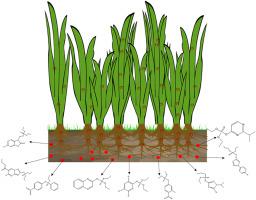Journal of Environmental Management ( IF 8.0 ) Pub Date : 2021-09-09 , DOI: 10.1016/j.jenvman.2021.113657 Chijioke Olisah 1 , Lucienne R D Human 2 , Gletwyn Rubidge 3 , Janine B Adams 4

|
Organophosphate pesticides (OPPs) are persistent in the environment, but little information is available on their bioaccumulation in seagrass. In this study, the seagrass – Zostera capensis was collected from Swartkops Estuary in South Africa to investigate the bioaccumulation of OPPs from contaminated sediments and the water column. This plant was chosen because it grows abundantly in the estuary's intertidal zone, making it a viable phytoremediator in the urban environment. Extraction was performed by the QuEChERS method followed by GC-MS analysis. The mean concentration of ∑OPPs ranged from 0.01 to 0.03 μg/L for surface water; 6.20–13.35 μg/kg dw for deep-rooted sediments; 18.79–37.75 μg/kg dw for leaf tissues and 12.14–39.80 μg/kg dw for root tissues of Z. capensis. The biota-sediment accumulation factors (BSAFs) were greater than one, indicating the potential for Z. capensis to bioaccumulate and intercept the targeted pesticides. A weak insignificant correlation observed between log BSAFs and log Kow indicates that the bioaccumulation of OPPs in tissues of Z. capensis were not dependent on the Kow. Eight of the selected pesticides had root-leaf translocation factors (TFr-l) greater than 1, indicating that Z. capensis can transport these chemicals from roots to leaves. The results from this study implies that this plant species can clean up OPP contamination in the environment.
中文翻译:

隔离在海草物种组织中的有机磷杀虫剂 - 来自受污染流域的 Zostera capensis
有机磷农药 (OPP) 在环境中具有持久性,但关于它们在海草中的生物累积性的信息很少。在这项研究中,海草 - Zostera capensis 从南非的 Swartkops 河口采集,以研究受污染沉积物和水体中 OPP 的生物积累。选择这种植物是因为它在河口的潮间带大量生长,使其成为城市环境中可行的植物修复剂。通过 QuEChERS 方法进行提取,然后进行 GC-MS 分析。对于地表水,∑OPPs 的平均浓度范围为 0.01 至 0.03 μg/L;6.20–13.35 μg/kg dw 对于深根沉积物;18.79–37.75 μg/kg dw 的叶组织和 12.14–39.80 μg/kg dw 的 Z. capensis 根组织。生物群沉积物积累因子 (BSAF) 大于 1,表明 Z. capensis 具有生物积累和拦截目标农药的潜力。在 log BSAFs 和 log Kow 之间观察到的微弱无关紧要的相关性表明 OPPs 在 Z. capensis 组织中的生物积累不依赖于 Kow。选定的农药中有八种具有大于 1 的根叶易位因子 (TFr-l),表明 Z. capensis 可以将这些化学物质从根部运送到叶部。这项研究的结果表明,这种植物物种可以清除环境中的 OPP 污染。选定的农药中有八种具有大于 1 的根叶易位因子 (TFr-l),表明 Z. capensis 可以将这些化学物质从根部运送到叶部。这项研究的结果表明,这种植物物种可以清除环境中的 OPP 污染。选定的农药中有八种具有大于 1 的根叶易位因子 (TFr-l),表明 Z. capensis 可以将这些化学物质从根部运送到叶部。这项研究的结果表明,这种植物物种可以清除环境中的 OPP 污染。











































 京公网安备 11010802027423号
京公网安备 11010802027423号